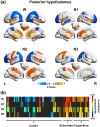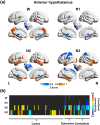Functional connectivity of the human hypothalamus during wakefulness and nonrapid eye movement sleep
- PMID: 33960583
- PMCID: PMC8249893
- DOI: 10.1002/hbm.25461
Functional connectivity of the human hypothalamus during wakefulness and nonrapid eye movement sleep
Abstract
Animal experiments indicate that the hypothalamus plays an essential role in regulating the sleep-wake cycle. A recent neuroimaging study conducted under resting wakefulness conditions suggested the presence of a wake-promoting region and a sleep-promoting region in the human posterior hypothalamus and anterior hypothalamus, respectively, and interpreted their anticorrelated organization in resting-state functional networks as evidence for their opposing roles in sleep-wake regulation. However, whether and how the functional networks of the two hypothalamic regions reorganize according to their wake- or sleep-promoting roles during sleep are unclear. Here, we constructed functional networks of the posterior and anterior hypothalamus during wakefulness and nonrapid eye movement (NREM) sleep using simultaneous electroencephalography and functional magnetic resonance imaging data collected from 62 healthy participants. The functional networks of the posterior and anterior hypothalamus exhibited inversely correlated organizations during both wakefulness and NREM sleep. The connectivity strength of the posterior hypothalamic functional network was stronger during wakefulness than during stable sleep. From wakefulness to sleep, the anterior cingulate gyrus, paracingulate gyrus, insular cortex, and fontal operculum cortex showed decreased positive connectivity, while the precentral gyrus and postcentral gyrus showed decreased negative connectivity with the posterior hypothalamus. Additionally, the insular cortex and frontal operculum cortex showed negative connectivity during wakefulness and positive connectivity during sleep with the anterior hypothalamus, exhibiting an increasing trend. These findings provide insights into the correspondence between the functional network organizations and hypothalamic sleep-wake regulation in humans.
Keywords: functional connectivity; hypothalamus; sleep-wake regulation; tuberomammillary nucleus; ventrolateral preoptic nucleus.
© 2021 The Authors. Human Brain Mapping published by Wiley Periodicals LLC.
Conflict of interest statement
The authors declare no conflict of interest.
Figures







Similar articles
-
Connectivity of sleep- and wake-promoting regions of the human hypothalamus observed during resting wakefulness.Sleep. 2018 Sep 1;41(9):zsy108. doi: 10.1093/sleep/zsy108. Sleep. 2018. PMID: 29850898 Free PMC article.
-
Altered thalamic connectivity in insomnia disorder during wakefulness and sleep.Hum Brain Mapp. 2021 Jan;42(1):259-270. doi: 10.1002/hbm.25221. Epub 2020 Oct 13. Hum Brain Mapp. 2021. PMID: 33048406 Free PMC article.
-
Brain activation and hypothalamic functional connectivity during human non-rapid eye movement sleep: an EEG/fMRI study.Brain. 2006 Mar;129(Pt 3):655-67. doi: 10.1093/brain/awh686. Epub 2005 Dec 9. Brain. 2006. PMID: 16339798
-
The sleep switch: hypothalamic control of sleep and wakefulness.Trends Neurosci. 2001 Dec;24(12):726-31. doi: 10.1016/s0166-2236(00)02002-6. Trends Neurosci. 2001. PMID: 11718878 Review.
-
[Sleep-wake cycle mechanisms].Braz J Psychiatry. 2005 May;27 Suppl 1:33-9. doi: 10.1590/s1516-44462005000500007. Epub 2005 Jul 28. Braz J Psychiatry. 2005. PMID: 16082453 Review. Portuguese.
Cited by
-
Sleep neuroimaging: Review and future directions.J Sleep Res. 2025 Feb 12:e14462. doi: 10.1111/jsr.14462. Online ahead of print. J Sleep Res. 2025. PMID: 39940102 Review.
-
Regional brain dysfunction in insomnia after ischemic stroke: A resting-state fMRI study.Front Neurol. 2022 Nov 25;13:1025174. doi: 10.3389/fneur.2022.1025174. eCollection 2022. Front Neurol. 2022. PMID: 36504641 Free PMC article.
-
Hypothalamus volumes in adolescent Myalgic Encephalomyelitis/Chronic Fatigue Syndrome (ME/CFS): impact of self-reported fatigue and illness duration.Brain Struct Funct. 2023 Sep;228(7):1741-1754. doi: 10.1007/s00429-023-02682-3. Epub 2023 Aug 3. Brain Struct Funct. 2023. PMID: 37537279 Free PMC article.
-
Deficient sleep, altered hypothalamic functional connectivity, depression and anxiety in cigarette smokers.Neuroimage Rep. 2024 Mar;4(1):100200. doi: 10.1016/j.ynirp.2024.100200. Epub 2024 Mar 5. Neuroimage Rep. 2024. PMID: 38605733 Free PMC article.
-
The altered hypothalamic network functional connectivity in chronic insomnia disorder and regulation effect of acupuncture: a randomized controlled neuroimaging study.BMC Complement Med Ther. 2024 Nov 14;24(1):396. doi: 10.1186/s12906-024-04703-y. BMC Complement Med Ther. 2024. PMID: 39543627 Free PMC article. Clinical Trial.
References
-
- Allen, P. J. , Josephs, O. , & Turner, R. (2000). A method for removing imaging artifact from continuous EEG recorded during functional MRI. NeuroImage, 12, 230–239. - PubMed
-
- Allen, P. J. , Polizzi, G. , Krakow, K. , Fish, D. R. , & Lemieux, L. (1998). Identification of EEG events in the MR scanner: The problem of pulse artifact and a method for its subtraction. NeuroImage, 8, 229–239. - PubMed
-
- Baroncini, M. , Jissendi, P. , Balland, E. , Besson, P. , Pruvo, J. P. , Francke, J. P. , … Prevot, V. (2012). MRI atlas of the human hypothalamus. NeuroImage, 59, 168–180. - PubMed
Publication types
MeSH terms
LinkOut - more resources
Full Text Sources
Other Literature Sources

